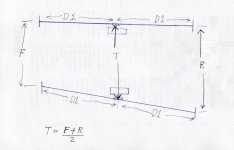OK, I’m ‘the aussie guy’ and the reason why I specify aiming the lasers on the ‘pie-plates’ (standoffs) to the rear while measuring the width at the front wheels is that the Spyder has a small amount of negative camber. It’s only 3mm (about 1/8”) on average, and that average is important – in other words, it’s slightly different on every bike, which doesn’t say a lot for assembly accuracy. I use a set-square on the FLAT floor so the laser dot hits the edge of the square-blade to give a ‘true vertical’ measurement, and that is marked on masking tape on the floor. Pointing the laser down to the floor will result in a slightly wider width measurement. You don’t need to roll the bike forward or backward to measure the width – you can slide a tape under the curve of the wheels at the exact point below the rear of the wheel rim, so avoiding any parallax error in measurement. That gives you a fairly accurate width measurement.
Yes, the rear of the ‘box’ is measured outward from the rear-most point of the rear wheel rim, so that DOES assume that the rear wheel is running true. But remember that the ‘box’ is about five time the diameter of the front wheels long, so all the measurements at the back of the bike are multiplied five times – that 1/8” camber ‘spread’ can be clearly measured over that distance. That’s the whole point of using lasers. You read the measurements where they are magnified, not at the front wheels.
Lastly, because the Spyder is rear-wheel-drive, the front wheels tend to spread IN MOTION so that any toe-out is exaggerated, any toe-in is reduced. The amount will depend on the amount of wear and tear in front suspension and steering, but is usually in the order of 0.5mm, so the amount of toe-in (at the wheels) needs to be at least that much! Just watching the laser dots on the targets when someone climbs onto the bike doesn’t show any left-right variation – just up-down variation as the bike squats down.
After dozens of Spyders aligned and NOBODY offering anything except praise, I think that this ‘imperfect’ system is quite good enough.

